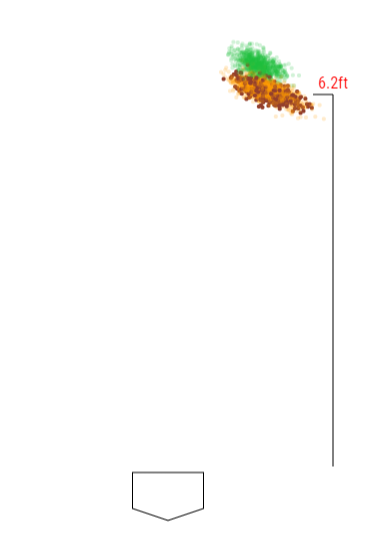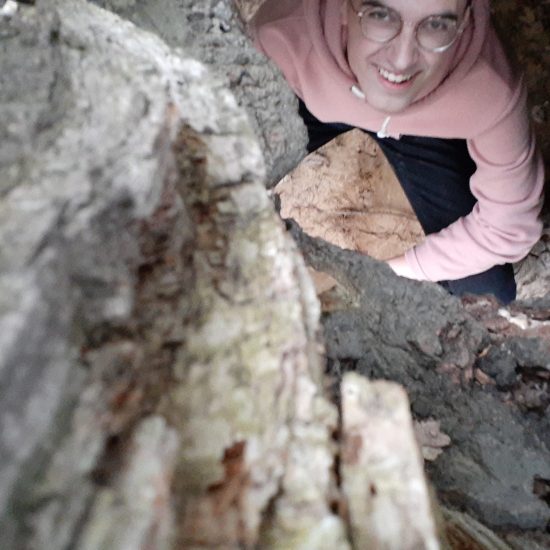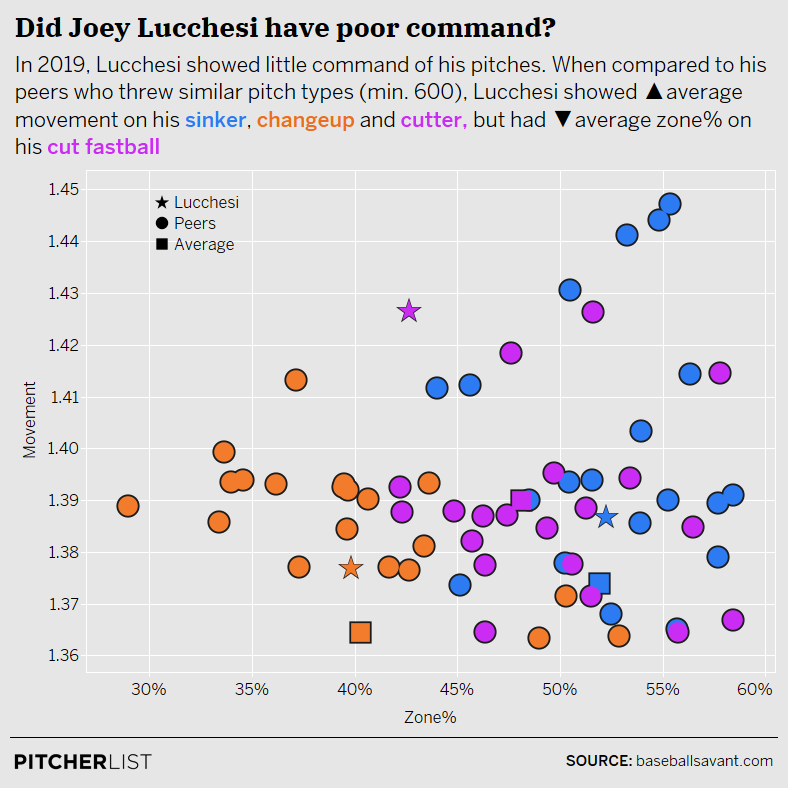Three years ago, Joey Lucchesi was considered to be one of Padres’ top prospects, making numerous organizational top-ten lists and squeaking into the top-100 for all of baseball. At first glance, his career up to this point has been solid for a player with that level of prospect pedigree. He hasn’t lit the league on fire, but many borderline top-100 prospects never contribute to their major league team whatsoever. Baseball is hard.
Still, Lucchesi shouldn’t necessarily be viewed as a rousing success, either. He’s succeeded not because of an excellent repertoire or pinpoint accuracy, but instead because of a unique, deceptive delivery and a one-of-a-kind pitch. While he’s gotten outs, batters who see him more often can know exactly when he throws his unique churve, and they could be able to hit him more consistently.
Lucchesi features three pitches: a sinking fastball, a cutter, and a changeup/curveball combination affectionately nicknamed a churve.
https://gfycat.com/highlevelsameamericancurl
Lucchesi likes to begin plate appearances with his sinking fastball, throwing it about two-thirds of the time as his first pitch. He probably does so because of his solid, if unspectacular command of this pitch. His 51% zone rate on the fastball is six percent higher than his cutter and 11% higher than his churve. Lucchesi is probably able to command the pitch relatively well because it moves so little. In fact, Baseball Savant estimates the average movement of the pitch to be less than two inches. For context, that’s about two-and-a-half inches less than the average sinker. In conjunction with the lack of movement, Lucchesi struggles to throw the pitch with any significant speed or spin rate. He tends to sit at about 90 mph, which is well below the league average of 93.6.
Because of these generally poor pitch characteristics, the offering isn’t anything special, inducing about an 18% whiff rate. Lucchesi threw this pitch over half the time, leading to a slightly inflated pVAL of 9.7. It may seem fairly pedestrian, making it seem less than noteworthy, but it becomes concerning when we look at how it plays off of his cutter.
https://gfycat.com/greathappyaustralianshelduck
Lucchesi throws the cutter in the same velocity range as his fastball, and it generally moves about six inches to his glove side. He tends to throw the pitch inside towards righties and away from lefties. The pitch above is reflective of fairly typical cutter placement for him.
Lucchesi only uses the cutter about 13% of the time, and for good reason. It got absolutely shelled last year, allowing a line drive rate of 26% and a wRC+ of 140. The pitch profiled poorly in 2018 as well, as he allowed a 236 wRC+ in a small sample. With the limited usage and poor results, this thing is nothing more than a show-me pitch.
https://gfycat.com/warmthirdbelugawhale
And here’s the churve, Lucchesi’s best pitch. Lucchesi tends to throw it low and gets an impressive 38% whiff rate on the pitch. Part of that is because of an impressive amount of vertical drop on the pitch and part is because of his deceptive delivery. Eno Sarris of The Athletic posited on a recent podcast that if pitchers received a deception score for how hard it would be for batters to pick up a pitchers pitches, Lucchesi’s churve would finish near the top of the list.
Lucchesi struggles to control the pitch, though, with only a 38% zone rate. While Lucchesi has the hardest time getting his churve in the zone, he doesn’t have great control over any of his other pitches. Command+, a proprietary stat from STATS, Inc that only appears sporadically and partially in Sarris pieces at The Athletic, estimates Lucchesi’s control as one of the worst in baseball. See this graphic for additional context:
The table shows zone rate mapped against movement on various pitches. We created the table that way because pitches that move more are harder to control. To determine movement, we took the horizontal and vertical movements of each pitch and found the square root of their added squares.
While that may seem confusing, the most important thing to know is this: it does a good job of showing how much each pitch type moves in general. This is helpful because a pitcher whose curveball drops 14 inches needs less control to be effective than a fastball that doesn’t move at all.
This data is far less pessimistic about Lucchesi’s control than Command+. This may be because Command+ looks not only at zone rate but also the location within the zone and distance a pitch missed when it missed the zone. Still, this table shows Lucchesi’s control as below average for all pitchers, and it’s worth noting that the data includes relievers, for whom control can be less consistent.
Because Lucchesi has poor command and his pitches — aside from the churve — are pedestrian at best, he needs excellent pitch tunneling to pitch effectively. Tunneling occurs when pitches look the same as they leave the pitcher’s hand — almost as though they were all traveling through a tunnel together — before heading in different directions just before a batter has to decide to swing. The best pitch tunneling looks like a partially peeled banana: all the pitches follow in the exact same direction at first before peeling off in all different directions. Unfortunately for Lucchesi, his pitch tunneling is extremely bad, to the point that he tips his best pitch before it even leaves his hand.  This image shows Lucchesi’s release points for each of his pitches in 2019. Note how the red and yellow dots, representing his fastball and his cutter, overlay each other almost perfectly. While his release point on these pitches is erratic, they’re released from the same spots. The green dots, however, signify his churve. That release point is about six inches higher than his churve on average. When a batter steps to the plate against Lucchesi, they can watch his arm slot as he throws. If the release point is elevated, they know to expect a churve. If not, then the pitch will be a fastball or cutter.
This image shows Lucchesi’s release points for each of his pitches in 2019. Note how the red and yellow dots, representing his fastball and his cutter, overlay each other almost perfectly. While his release point on these pitches is erratic, they’re released from the same spots. The green dots, however, signify his churve. That release point is about six inches higher than his churve on average. When a batter steps to the plate against Lucchesi, they can watch his arm slot as he throws. If the release point is elevated, they know to expect a churve. If not, then the pitch will be a fastball or cutter.
Because of this flaw in Lucchesi’s delivery, his lack of control becomes more prominent. Imagine a batter’s thought process when they face Lucchesi. If the release point is elevated, they know ahead of time that not only is Lucchesi throwing his most unhittable pitch, but also that he has only about a 33% chance of locating it within the zone. If, instead, Lucchesi lowered his release point, the batter knows he’s facing either a fastball or a cutter. The two pitches have no speed differentiation, meaning that the timing will be easy for the batter to pick up on. With one pitch offering no significant movement and the other pitch allowing a 142 wRC+, batters have a lot of opportunity to hit him fairly hard.
Lucchesi’s problems here seem significant, so what can he do to overcome them? The answer probably starts with his mechanics. If he can become more consistent with his delivery, not only will he stop tipping his pitches, but his control should increase. Better control would help Lucchesi instantly. Lucchesi tends to throw low and inside most often, which is where he is hit hardest. If Lucchesi is able to start elevating his fastball and throwing more pitches outside, where he’d be able to use all of the plate, batters wouldn’t know what to expect quite as much. This is especially important because Lucchesi threw in the bottom third or below the zone over half the time in 2019. But, remember, he doesn’t have great spin or velo, both of which help pitches up in the zone play better.
A solution is tricky. Unfortunately, changing Lucchesi’s mechanics is probably easier said than done. His release point variance has been a problem longer than just 2019, as he had a separate release point for his churve than his other pitches in 2018 as well. Changing mechanics fundamentally mid-season is unheard of, meaning that Lucchesi is likely headed for a poor season this year.
While some fantasy managers have been drafting Lucchesi with the idea that he would at least get innings that help stabilize their pitching staff, he might not be a lock to get any innings at all. Roster Resource has him penciled into the 5th spot for the Padres, but as recently as last week Kevin Acee of the San Diego Union-Tribune reported that he was still in a battle with Cal Quantrill. Even if Lucchesi does win the spot, teams aren’t likely to let their fifth starters go deep into games. Lucchesi’s ADP is slightly higher than pitchers like Aaron Civale and Garrett Richards, both of whom I prefer over Lucchesi. If you own Lucchesi this year, consider trying to trade him for one of those pitchers. Do so now, before we find out whether he has a spot this year. Even if he does, his value could tank because of a lack of innings or a lack of quality outings.
Photo by Cody Glenn/Icon Sportswire | Feature Graphic Designed by James Peterson (Follow @jhp_design714 on Instagram & Twitter)



Josiah, good read. Hopefully, he is aware of this issue and is trying to fix it.
Impressive article.